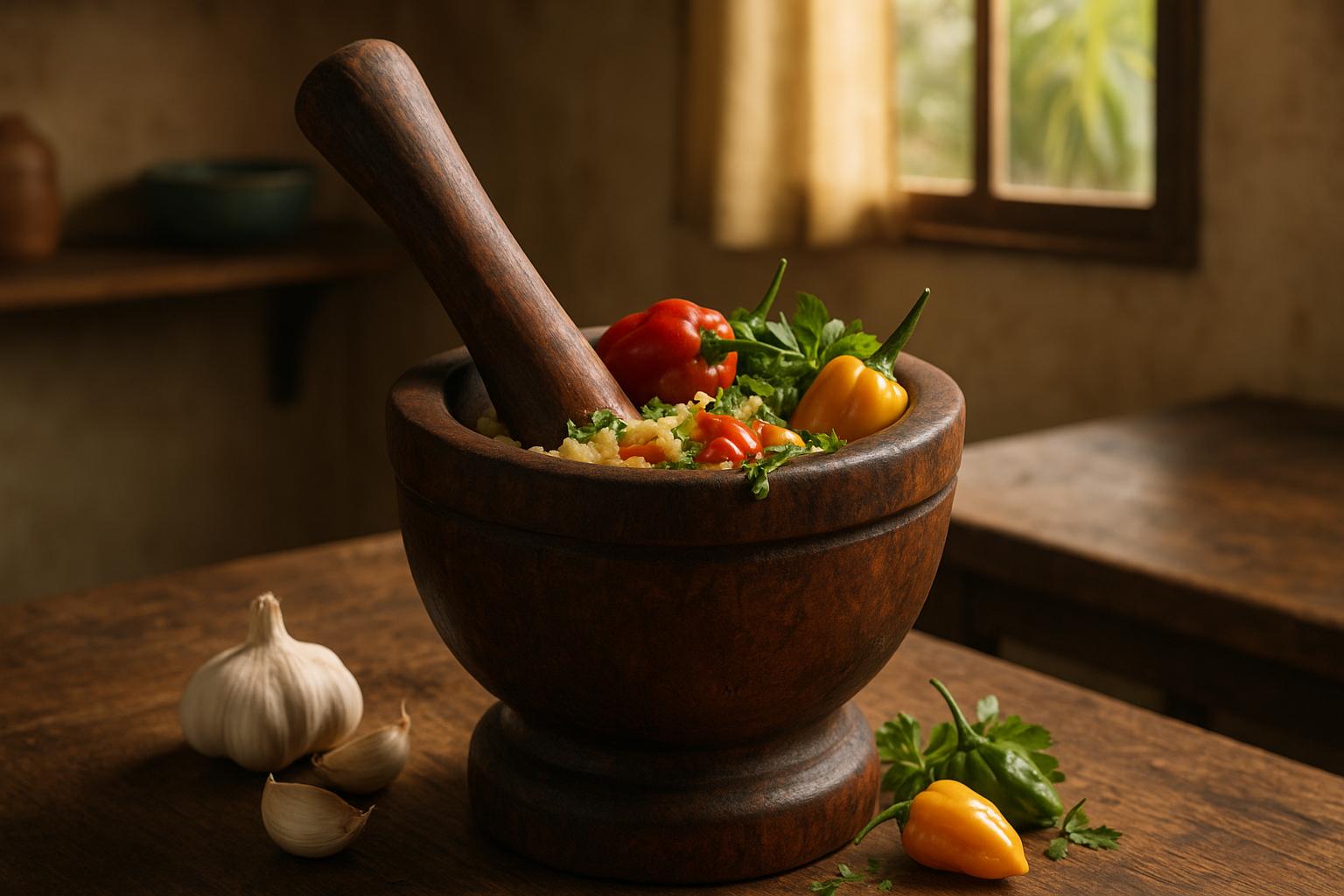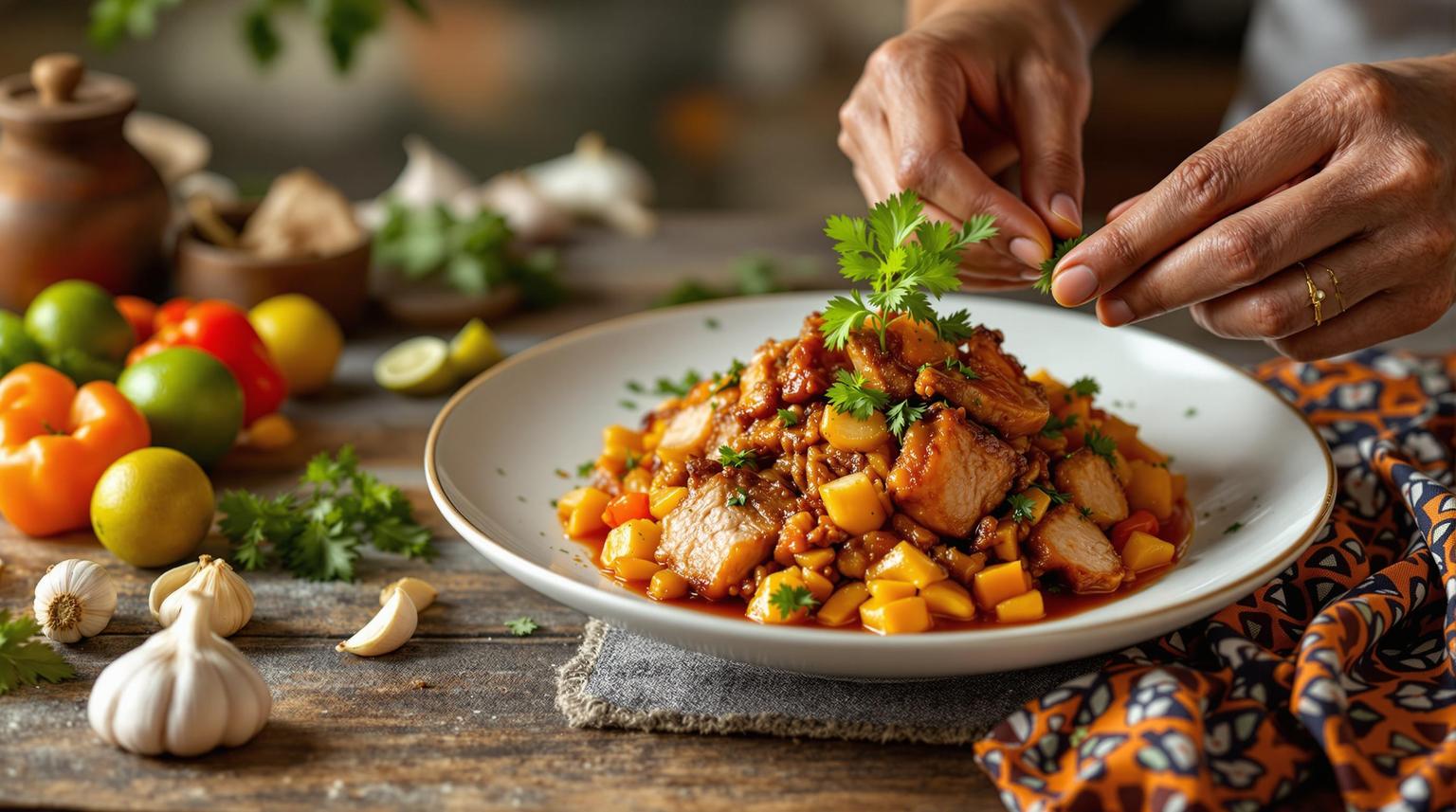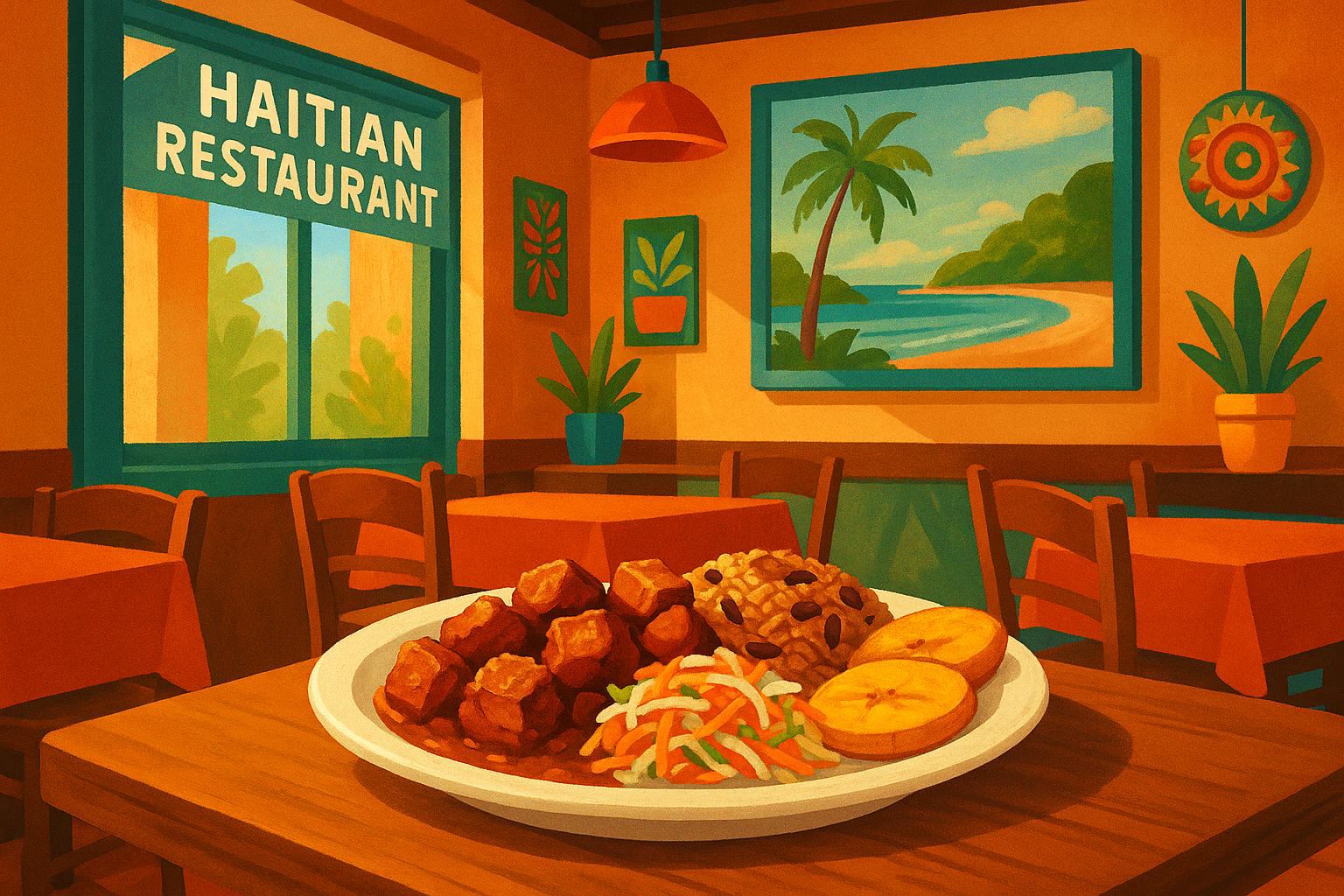Fritay is a Haitian street food platter featuring fried meats, plantains, and fritters, paired with pikliz, a spicy pickled slaw. It includes staples like griot (fried pork), banan peze (fried plantains), akra (malanga fritters), and tassot (fried beef or goat). Vendors often add regional twists, such as seafood in coastal areas or unique spice blends. Fritay is deeply tied to Haitian gatherings, festivals, and street food culture, bringing people together through its bold flavors and simplicity.
Key highlights:
- Main Components: Griot, tassot, banan peze, akra, sweet potatoes, breadfruit.
- Accompaniments: Pikliz, sauce ti-malice, lime wedges, bread.
- Where to Find It: Cities like Miami, Boston, and New York are hubs for fritay, with HaitianFoods.org offering a directory of vendors and restaurants.
Fritay isn't just food - it's a shared experience. Dive in with your hands, enjoy the vibrant flavors, and explore its roots through every bite.
How To Make Fritay – Cooking Delicious Haitian Food!
Main Components of a Fritay Platter
A fritay platter is a perfect harmony of flavors and textures, with each element playing a role in creating a satisfying and flavorful meal. By breaking down its components, we can better appreciate the culinary artistry behind this Haitian favorite.
Common Meats in Fritay
One of the stars of any fritay platter is griot. This iconic dish features pork shoulder marinated in a vibrant mix of garlic, lime juice, and spices. After marinating, the meat is slow-cooked until tender and then fried to achieve a golden, crispy exterior while keeping the inside juicy and flavorful. Griot is a staple of Haitian cuisine and a must-have on any fritay plate.
Another popular choice is tassot, which is typically made from beef or goat. The meat is salted, dried, and fried, resulting in a chewy texture and bold, concentrated flavor. Tassot de cabrit (goat tassot) holds a special place in the hearts of fritay lovers.
For those seeking variety, vendors often include fried fish or boukannen (smoked herring) as alternative protein options. Some platters also feature chiktay (fried chicken pieces) or sosis (Haitian-style sausages), ensuring there's something for everyone.
While the proteins steal the spotlight, the starches provide the essential base that ties the platter together.
Main Starches
Banan peze, or twice-fried green plantains, is a cornerstone of most fritay platters. The plantains are sliced, fried until tender, flattened, and fried again to create a crispy exterior with a soft center. This preparation method adds both texture and flavor to the dish.
Another beloved addition is sweet potatoes, which are sliced into rounds or wedges and fried until their natural sugars caramelize, creating a crispy, sweet contrast to the savory meats.
When in season, breadfruit (lam veritab) is a common feature. This starchy fruit is sliced and fried to a golden perfection, offering a mild flavor and a texture that absorbs the platter's bold flavors beautifully.
Akra, made from grated malanga root blended with garlic, scotch bonnet peppers, and spices, is another favorite. These deep-fried fritters add a crispy texture and a subtle spicy kick, rounding out the starch options.
To balance the richness of the fried elements, no fritay platter is complete without its signature accompaniments.
Key Accompaniments
Pikliz, a spicy and tangy pickled slaw, is a must-have. Its bright acidity and heat cut through the heaviness of the fried components, with each vendor putting their own spin on this classic condiment.
Sometimes, fritay platters also include sauce ti-malice, a chunky, spicy sauce made with onions, bell peppers, garlic, and scotch bonnet peppers. This sauce not only adds moisture but also enhances the overall flavor with its bold, zesty notes.
To finish, lime wedges and bread are often included. The lime adds a burst of acidity, while the bread serves as a neutral base, soaking up the platter’s rich flavors and ensuring nothing goes to waste.
Fritay Variations by Region and Vendor
While the essence of fritay stays true to its roots, vendors often tweak their recipes to match the ingredients and flavors of their surroundings, creating subtle yet delightful differences.
Regional Differences in Ingredients
The staples of fritay - griot, fried plantains, and akra - are consistent across regions, but local influences can add unique twists. For example, in coastal areas, you might find vendors incorporating seafood, such as smoked fish like boukannen, into their offerings. In bustling urban centers, the choice of starches or side dishes may shift based on what's readily available or popular locally. Even pikliz, the tangy, spicy slaw that’s a fritay staple, can have slight variations in its preparation depending on the vendor. These regional touches add layers of character to fritay while staying true to its Haitian roots.
Vendor-Specific Recipes
Many fritay vendors take pride in recipes passed down through their families. These recipes often differ in how the meat is marinated, the balance of spices, or the frying techniques used. Each vendor adds their own flair, tweaking flavors and heat levels to create a signature dish. These personal touches make every fritay stand out, offering a unique taste of Haitian culinary artistry.
This blend of tradition and individual creativity ensures fritay remains vibrant and beloved, with every bite celebrating the diversity of Haitian cuisine.
The Fritay Experience
Fritay isn't just food; it's a celebration of Haitian culture that unites people in a way few dishes can.
Fritay as Social Food
What makes fritay special is how it turns any gathering into a lively communal event. Unlike meals meant for one, fritay is all about sharing. Large platters invite people to come together, sparking conversations, laughter, and a sense of connection.
"The Haitian Fritay is a culinary experience that transcends the boundaries of a simple street meal. It is a true institution, a cultural heritage that brings together local residents and visitors around a common passion for unique flavors."
Some elements of fritay, like griot, are often reserved for special occasions. These dishes carry family recipes passed down through generations, keeping traditions alive. The act of sharing fritay not only enhances the meal but also preserves Haitian heritage, as stories and memories are exchanged over each bite.
This sense of togetherness continues through the way fritay is served, where presentation and sensory appeal play a key role in the experience.
How Fritay is Served and Enjoyed
Fritay doesn't just taste good - it engages all your senses. The experience starts with the bustling energy of street vendors, the mouthwatering aromas of food frying, and the lively chatter of people gathered around.
Vendors present fritay on large platters [1], carefully arranging griot, plantains, and akra to create a feast for the eyes. The golden-brown tones and mix of textures not only make the dish visually appealing but also reflect the rich flavors within. This thoughtful presentation highlights the pride and tradition behind every recipe, reinforcing fritay's role as a unifying force.
Eating fritay is refreshingly simple. There's no need for utensils - just dive in with your hands. Bread or fried plantain becomes a tool for scooping, adding to the casual, laid-back vibe.
Every bite is a sensory adventure. The crunch of fried plantains, the rich aroma of spices, and the vibrant colors all come together to create an unforgettable experience. It's not just food; it's a celebration of Haitian culture that brings people together - whether they're locals reliving cherished memories or newcomers discovering the flavors for the first time.
sbb-itb-80c33ff
Where to Find Fritay in the United States
Finding authentic fritay in the U.S. is easier when you know where to look, especially in cities with strong Haitian communities and through resources that spotlight traditional recipes.
Cities with Large Haitian Communities
South Florida is a great starting point for authentic fritay. Cities like Miami, with its vibrant Haitian neighborhoods - such as Little Haiti - are known for preserving traditional cooking. Websites like HaitianFoods.org can guide you to well-regarded eateries in areas such as Miami, Fort Lauderdale, North Miami, and Liberty City, where classic fritay staples are a highlight. These hubs make it simple to explore Haitian culinary traditions across the U.S.
Using HaitianFoods.org to Find Fritay

HaitianFoods.org is a go-to platform for discovering Haitian restaurants nationwide. The site connects food lovers with establishments serving traditional dishes like griot, tassot, and other fritay favorites.
"Discover the best Haitian restaurants near you! From griot to tassot, find authentic flavors and hidden gems in your city." [3]
The platform streamlines your search by offering detailed listings of restaurants and their menus. You can easily search for dishes such as griot, tassot, legume, or fried pork.
As of August 2025, HaitianFoods.org highlights several standout options. For example, Cecibon Restaurant in Miami/Fort Lauderdale, Lakay Food Spot in North Miami, and Naomi's Garden Restaurant in Liberty City are praised for their authentic fritay offerings [2]. These examples reflect the platform’s commitment to showcasing genuine Haitian cuisine and fostering connections within the community.
Tips for Finding Good Fritay Vendors
Once you’ve got a list of potential spots, here are some tips to help you identify top-notch fritay vendors:
- Fresh Ingredients and Tradition: Quality vendors prioritize fresh ingredients and stay true to traditional recipes [4].
- Customer Reviews: Look for reviews that mention a welcoming, home-like atmosphere and consistent satisfaction [4].
- Renowned Chefs: Some vendors stand out for their culinary skill. For instance, in May 2023, Caribbean Pleasure in San Diego, CA, earned recognition for blending traditional Haitian flavors with a modern touch [4]. Similarly, Ansanm in Milford, NH, led by Top Chef contestant Chris Viaud, and Kann Restaurant in Portland, OR, helmed by James Beard Award-winning chef Gregory Gourdet, have elevated Haitian cuisine while honoring its roots [4].
When visiting a fritay vendor, pay attention to how they prepare their dishes. Authentic vendors fry their components fresh throughout the day, ensuring the crispy textures and bold flavors that make fritay a standout experience.
Conclusion
Fritay, with its deep roots and lively street food culture, holds a special place in Haitian culinary traditions. Here's a closer look at what makes it so memorable.
Why Fritay Stands Out
Fritay is more than just food - it's a symbol of community and heritage. This beloved Haitian street food brings together bold, seasoned meats, satisfying starches, and classic accompaniments like pikliz. It’s a celebration of flavor and tradition that connects people through shared experiences.
What makes fritay even more exciting is how it evolves. Regional spins and creative touches from vendors add new layers to its appeal. Whether you’re savoring a traditional plate in Miami’s Little Haiti or sampling innovative takes across the U.S., fritay keeps its roots intact while embracing local flavors. It’s this balance that makes it both familiar and fresh, no matter where you find it.
Where to Find Fritay
Ready to dive into the world of fritay? Check out HaitianFoods.org to discover authentic Haitian eateries near you. Some must-visit spots include Naomi's Garden Restaurant & Lounge in Miami's Liberty City and Cecibon Restaurant, serving both Miami and Fort Lauderdale areas [2]. If you're exploring further afield, look out for hidden gems like the Fritay Haitian Cuisine food truck in Denver [5].
Whether you're a devoted fan of Haitian dishes or just looking to try something new, fritay offers a perfect introduction to the rich flavors and traditions of Haitian cuisine. It’s comfort food at its finest, with a side of cultural pride.
Why wait? Start your fritay adventure today.
FAQs
What sets griot and tassot apart in Haitian fritay, and how are they made?
Griot and Tassot: Haitian Fritay Favorites
When it comes to Haitian fritay, two dishes often steal the spotlight: griot and tassot. Each brings its own distinct taste and texture to the table, making them staples of Haitian cuisine.
Griot is all about tender pork shoulder. The meat is marinated in a mix of lime, garlic, and a blend of Haitian spices, giving it a vibrant flavor. After marinating, it's boiled until perfectly tender and then deep-fried, creating a crispy outer layer while keeping the inside juicy and flavorful.
Tassot, on the other hand, offers a different experience. Usually made with goat or beef, the meat is marinated, boiled until tender, and then fried. The result is a drier, chewier texture that stands in bold contrast to the softness of griot.
Both dishes highlight the savory, seasoned richness that defines Haitian fritay, making them unforgettable staples for anyone exploring this flavorful cuisine.
How do different regions in Haiti shape the flavors and ingredients in fritay?
Regional traditions in Haiti deeply influence the ingredients and flavors found in fritay platters. Along the coasts, fresh seafood like fried red snapper often takes center stage, reflecting the abundance of fish in those areas. Meanwhile, inland regions lean toward fried pork, beef, or plantains, highlighting the importance of local farming practices.
Even the spices and condiments tell a regional story. Take pikliz, for instance - a fiery pickled vegetable mix. Its level of heat or acidity can vary depending on where it’s made, adding a personal touch to the dish. These differences celebrate the diversity of local ingredients and cooking styles, ensuring that every fritay platter offers a taste of Haiti's rich culinary heritage.
How can I find authentic Haitian fritay vendors in the United States?
If you're looking to enjoy genuine Haitian fritay in the United States, start by visiting Haitian restaurants or food trucks that have strong community reviews. Street vendors and food trucks often prepare their dishes fresh on-site, offering a more traditional and flavorful experience.
Another great way to find authentic vendors is through word-of-mouth recommendations from members of the Haitian community. Many trusted vendors also maintain an active presence on social media, sharing their menus, locations, and cultural events. This not only reflects their dedication to quality but also their connection to Haitian traditions. With a little research and input from the community, you'll be well on your way to savoring authentic Haitian fritay while supporting local vendors.


